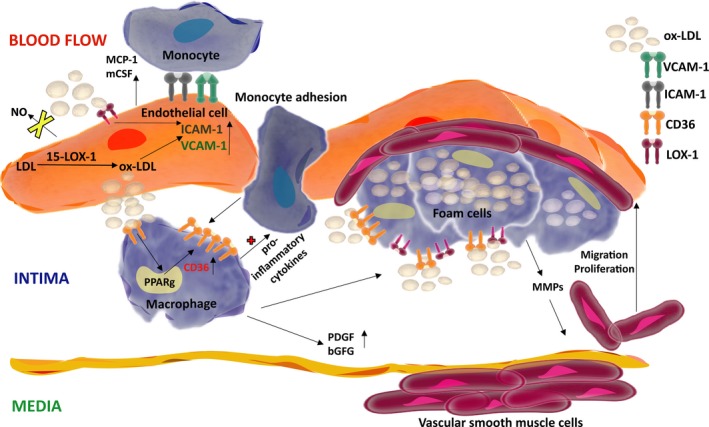Figure 3.

Involvement of 15‐LOX‐1 in the formation of atherosclerotic lesions. Formation of atherosclerotic lesions represents a series of highly dynamic events145 initiated by endothelial dysfunction, generally accompanied by a loss of production of nitric oxide (NO). Ox‐LDL generated from LDL by 15‐LOX‐1 activity in endothelial cells (ECs) induces the expression of cell surface adhesion molecules ICAM‐1 and VCAM‐1, enhancing the adhesive properties of endothelium. At early stages of plaque formation, expression of the major Ox‐LDL receptor, Lectin‐like oxidized LDL receptor‐1 (LOX‐1), increases in ECs. Moreover, Ox‐LDL stimulates ECs to secrete cytokines that promote the recruitment of monocytes from blood flow into the endothelial wall (intima), and differentiate into macrophages. These macrophages express several scavenger receptors such as cluster of differentiation 36 (CD36) and LOX‐1. Internalized Ox‐LDL may enhance CD36 expression (via PPARγ) which in turn facilitates the internalization of more Ox‐LDL, forming foam cells. ECs and macrophages also enhance platelet‐derived growth factor (PDGF) and basic fibroblast growth factor (bFGF) expression and secretion which induce vascular smooth muscle cell (VSMC) proliferation. Foam cells secrete matrix metallopeptidases (MMPs) that trigger VSMCs migration from the media into the intima via the degradation of the extracellular matrix (ECM). Later in the process, VSMCs can produce extracellular matrix factors, including interstitial collagen and elastin, and form a fibrous cap that covers the plaque, which are not shown here
